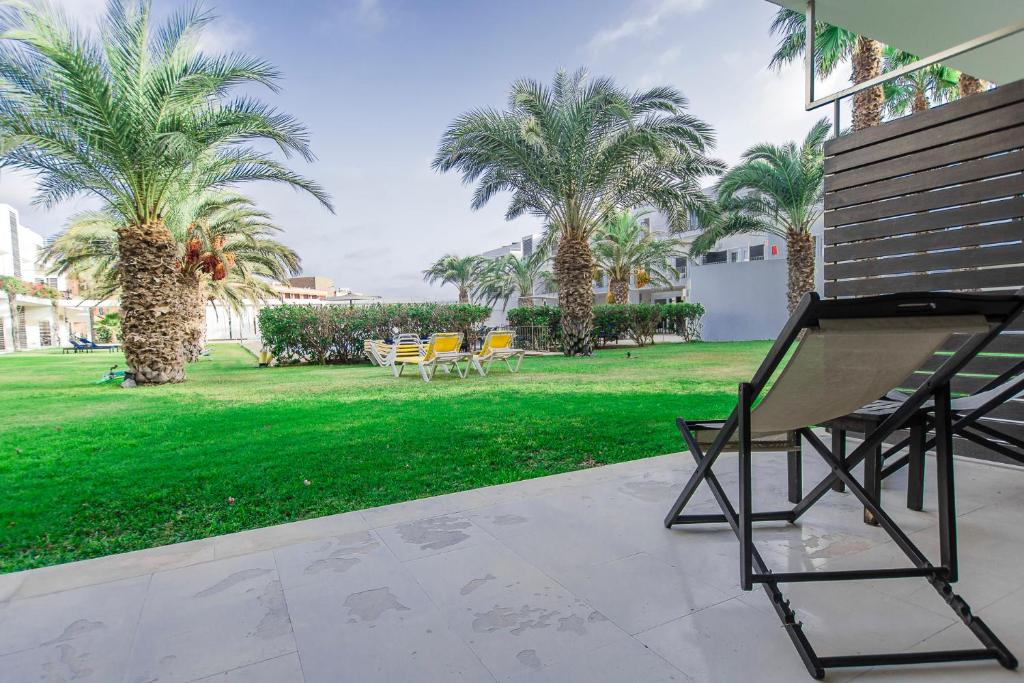You’re in for a real treat visiting Sal – the island’s subtropical desert climate means you’ll enjoy toasty temps year-round, with average highs reaching a sizzling 26.7°C in October. Nighttime lows are oh-so-comfy too, dipping to a pleasant 20.6°C in March. Don’t worry about rain ruining your plans – Sal sees just 90mm annually, mostly from August to October. Just brace yourself for that humid, muggy air, peaking at 84% in the wetter months. But hey, at least you can cool off in the crystal clear, 27°C waters! Sounds like the perfect island getaway, doesn’t it? If you want more juicy details on Sal’s weather, keep reading.
Principais conclusões
-
- The average yearly temperature in Sal is around 24.25°C (75.5°F), with the warmest month being September at 27.4°C (81.4°F) and the coolest being February at 21.8°C (71.3°F).
- Sal has a subtropical desert climate with minimal annual rainfall, averaging 90mm spread over 37.7 rainy days, with the wettest month being September with 28mm of rain.
- The driest months are January and February, which see no precipitation, while August is the wettest with 35mm of rain on average.
- Humidity levels in Sal range from 69% in January to 84% in June and July, contributing to a consistently muggy ambiance throughout the year.
- Sea temperatures range from 22°C in the winter to 27°C in the summer, making the best swimming months from July through November, peaking in September and October.
Climate Overview of Sal
Sal’s subtropical desert climate (BWh) is characterized by warm temperatures year-round. The average high temps range from a cozy 21.6°C in March to a toasty 26.7°C in October.
You can expect the lowest average lows around 20.6°C in March, with October boasting the warmest average high of 26.7°C. Rainfall is scarce, averaging just 90mm annually, with January seeing no precipitation at all and August being the wettest at 35mm.
Humidity fluctuates from a dry 72% in January and December to a muggy 84% in June and July. Daylight hours vary seasonally too, from 11 hours in December to 13 hours of sun in June.
Yearly Temperature Averages
Across the year, the yearly average temperature in Sal hovers around 24.25 °C (75.5 °F). Don’t worry, it’s not scorching hot – just pleasantly warm.
O warmest month is September, with an average of 27.4 °C (81.4 °F). Chilly February is the coolest, dipping to 21.8 °C (71.3 °F), though the mercury can reach a toasty 35 °C in August.
Nighttime temps range from 18 °C (64 °F) in December to 21.5 °C (71 °F) in September. The average wind speed is moderate, and the average sea temperature is comfortably warm.
Rainfall is minimal, but you can expect the wettest days in September.
-
- The warmest month is September, with an average of 27.4 °C (81.4 °F).
- Chilly February is the coolest, dipping to 21.8 °C (71.3 °F).
- Nighttime temps range from 18 °C (64 °F) in December to 21.5 °C (71 °F) in September.
- Rainfall is minimal, but you can expect the wettest days in September.
Monthly Temperature Breakdown
Throughout the year, Sal’s temperatures fluctuate within a fairly moderate range. The average temperatures typically vary between a chilly 20.6°C in March and a toasty 30.1°C in September.
February’s cooler temps, with an average of 21.8°C, make it the coldest month. But don’t worry – even the “coldest” days are pretty comfortable.
O warmest time is October, when the mercury can reach a balmy 26.7°C on average.
While Sal doesn’t get a ton of rain, September is the wettest month, with about 34.5mm over 3 days.
Annual Precipitation Patterns
The island’s overall annual precipitation sits at a modest 90 mm, spread across an average of 37.7 rainy days.
While the driest month is January with zero rainfall, August is the wettest, averaging 35 mm over 7.2 days. In fact, September typically sees the highest number of rainfall days, around 8 on average.
-
- Rainfall is infrequent and short-lived, mainly occurring from August to October during the brief rainy season.
- Humidity levels can reach up to 84% during these wet months, adding to the overall moisture in the air.
- So, while Sal may not be the rainiest place, those showers do pack a punch when they arrive!
Monthly Precipitation Breakdown
While the island’s overall annual precipitation paints a modest picture, a closer look at the monthly breakdown reveals more nuanced rainfall patterns.
During the driest months of January and February, you can expect zero rainy days and no precipitation whatsoever.
But come August, the wettest month, you’ll experience an average of 35 mm of rain over 7.2 days. September’s rainfall is also quite significant, averaging 28 mm over 8 rainy days.
As the year winds down, the showers gradually taper off, with just 2 mm of rain in October, 1.3 mm in November, and 3.4 mm in December.
Knowing the monthly precipitation breakdown can help you plan your activities and pack accordingly.
Humidity and Air Conditions
Sal’s atmospheric conditions are consistently humid throughout the year. The average humidity ranges from a low of 69% in January to a high of 77% in September, contributing to a noticeably muggy ambiance.
This desert climate maintains a persistently damp atmosphere, even as the year progresses.
-
- The highest average humidity occurs in September, making the air feel particularly thick and heavy.
- October’s 75% average humidity keeps conditions feeling humid as the month wears on.
- By November, the humidity drops slightly to 72%, signaling a gradual decline towards the end of the year.
- December sees the lowest average humidity at 70%, though the air still retains a humid character.
Wind Speed and Daylight Hours
In addition to the consistently humid atmosphere, Sal’s climate is characterized by fluctuating wind speeds and daylight hours throughout the year.
You can expect a slight rise in wind speeds from a brisk 20 kph in September to a lively 23 kph by December. However, the tradeoff is a gradual decrease in sunny days, from a lengthy 12 hours and 10 minutes in September to a mere 11 hours and 10 minutes by the winter months.
While the winds may be calmer during the summer, you’ll have ample opportunity to soak up the sun on those clear, bright days. Just be prepared for some breezy conditions as the year progresses!
Sea Temperature for Swimming
Complementing the varying wind speeds and daylight hours, Sal’s sea temperatures also fluctuate throughout the year, making for perfect swimming conditions during certain months.
From a chilly 22°C in the winter to a toasty 27°C in the summer, the waters around Sal offer a range of temperatures to suit every swimmer’s preference. The águas cristalinas enhance the beauty of local beaches, further contributing to the appeal of swimming in Sal.
O best time to visit for swimming is certainly July through November, with September and October being the peak, when the sea maintains a consistent 27°C.
Even November’s 26°C is still quite swimmable. However, by December, the temperature drops to a barely-acceptable 24.5°C, so it’s best to plan your beach time accordingly.
-
- The warmest months for swimming are July, August, September, and October.
- Sea temperatures range from 22°C in the cooler months to 27°C in the warmest months.
- The ideal time to visit Sal for swimming is September and October.
- December’s 24.5°C sea temperature may be too cool for some swimmers.
Weather Considerations for Travel
When planning a trip to Sal, weather conditions are a crucial consideration. The annual average temperature of 24.25°C (75.5°F) offers pleasant warmth, but September’s toasty 27.4°C (81.4°F) highs can be sweltering.
On the flip side, February’s cooler 21.8°C (71.3°F) may require some extra layers. Prepare for the UV index, which peaks during the hottest months.
October’s mild 26.8°C (80°F) and minimal rainfall make it an ideal time to explore. However, heavy downpours in September could put a damper on your plans.
December’s stable 23.3°C (74°F) and low 3.4mm of precipitation are perfect for outdoor adventures. Just be mindful of the humidity, ranging from 69% to 77%, which may affect your comfort.
Perguntas frequentes
What Is the Average Temperature in Sal?
The average temperature in Sal? It’s perfect for your carefree tropical getaway – a balmy 24.25°C year-round! Embrace Sal’s welcoming climate and make the most of its weather-blessed tourist haven.
What Is the Best Month to Visit Cape Verde?
The best month to visit Cape Verde is January or February. You’ll enjoy pleasant weather, ideal for outdoor activities, exploring local cuisine, and experiencing cultural festivals – all while reveling in the freedom and relaxation of the islands.
What Is the Rainiest Month in Cape Verde?
The rainiest month in Cape Verde is September, when the rain patterns reach their peak. This seasonal variation in the climate can greatly impact your freedom to enjoy the islands during this time.
When Not to Go to Cape Verde?
Avoid visiting Cape Verde during the rainy season, especially September and October, when heavy rainfall and humidity can disrupt travel plans. Consider health precautions and climate factors to plan your trip for the best weather experience.


Comentário (0)